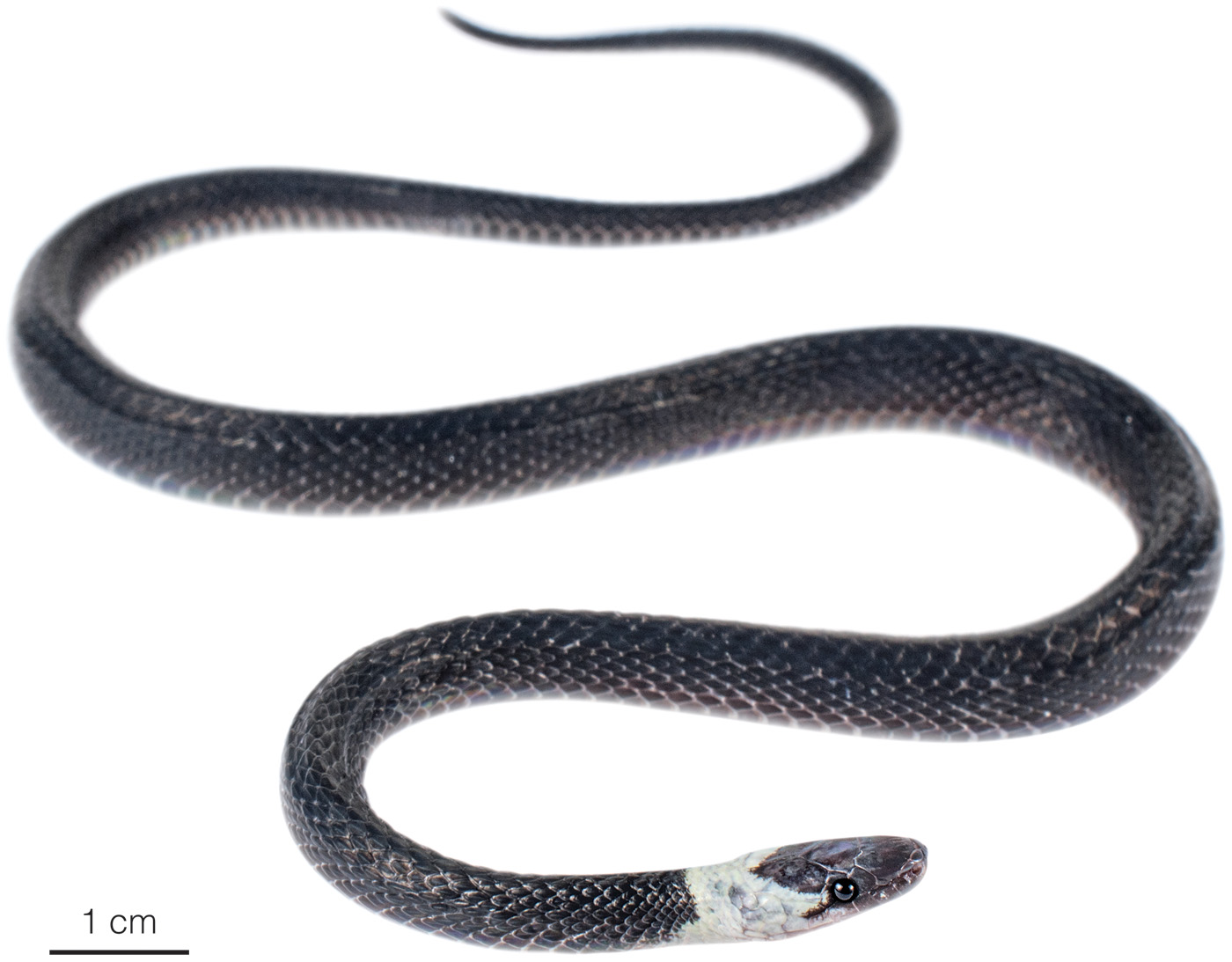Published April 23, 2024. Open access. | Purchase book ❯ |
Small-eyed Shadow-Snake (Emmochliophis miops)
Reptiles of Ecuador | Serpentes | Colubridae | Emmochliophis miops
English common names: Small-eyed Shadow-Snake, Myopic Shadow-Snake.
Spanish common name: Culebra sombría miope.
Recognition: ♂♂ 34.9 cmMaximum distance from the snout to the tip of the tail. Snout–vent length=25.8 cm. ♀♀ 39 cmMaximum distance from the snout to the tip of the tail. Snout–vent length=25.5 cm..1 Emmochliophis miops is a relatively small and slender snake that differs from other shadow snakes by having the following combination of characteristics: head flattened, snout distinctly sloping, dorsal scales strongly keeled and arranged in 19 rows at mid-body, prefrontal scales fused, and loreal scale absent (Fig. 1).2–4 This species differs from E. fugleri by having a yellowish white nuchal band as well as by having vertebrae without articular processes (zygapophyses) expanded into a rod-and-groove mechanism.2–5 From snakes of the genus Ninia, it differs by having fused, instead of paired, prefrontals.3 From Diaphorolepis, it differs by having a row of unexpanded single-keeled intervertebral scales (instead of expanded and double-keeled).6 From Synophis, it differs by lacking a loreal scale.2–5 From Nothopsis, it differs by having white, instead of blotched, ventral surfaces.3 There is no marked sexual dimorphism in the species.

Figure 1: Adult male of Emmochliophis miops from Parque Nacional Natural Munchique, Cauca department, Colombia.
Natural history: Emmochliophis miops is an extremely rare snake that inhabits evergreen lower-montane forests.1,4 The type locality in Ecuador is described as a farm with patches of forest whereas the locality in Colombia is a transition area between lowland rainforest and premontane cloud forest.1,4 The available information about the natural history of this species comes from only three observations,1,4 suggesting that Small-eyed Shadow-Snakes are nocturnal, terrestrial, cryptozoic, and apparently require humid areas. The two Colombian specimens were slowly crawling on the forest floor or between piles of rocks at night.1 These snakes appear particularly susceptible to changes in humidity and temperature, with individuals becoming thermally stressed and stiff if handled for more than just a few seconds.1 Remains of microteiid lizards were found in the stomach content of the holotype.5 No obvious defense behaviors were noted in any of the three known individuals.1
Conservation: Critically Endangered Considered to be facing imminent risk of extinction..7 Emmochliophis miops is included in this category, because at the time of the assessment in 2014, the species had not been since 1897.7 Although there is now a second locality for E. miops inside a protected area in Colombia (Parque Nacional Natural Munchique), the species should remain in the CR category because it has not been recorded in Ecuador in over a century despite intensive scientific collecting in Imbabura and Esmeraldas provinces.1,7 This suggests that, due to the loss of habitat in the type locality and surrounding areas, E. miops could be extirpated from Ecuador if its habitat continues to be destroyed. The most importat current threats are timber extraction and the creation of plantations and pastures for cattle ranching.1,7 Given the species’ susceptibility to changes in humidity and temperature, it may not persist in disturbed forests.
Distribution: Emmochliophis miops is only known from two localities along the western foothills of the Andes in Ecuador (Hacienda Paramba, Imbabura province; Fig. 2) and Colombia (Parque Nacional Natural Munchique, Cauca department).

Figure 2: Distribution of Emmochliophis miops in Ecuador. The star corresponds to the type locality: Hacienda Paramba, Imbabura province.
Etymology: The genus name Emmochliophis, which comes from the Greek words emmochlion (=a socket) and ophis (=snake),2 refers to the shape of the vertebral zygapophyses, which are expanded laterally, forming rod–and–bar assembly. The shape of the interlocking vertebrae is considered one of the most extreme skeletal modifications known in snakes.2 The specific epithet miops comes from the Greek myops (=myopic) and probably refers to the small eyes, a diagnostic character for the species mentioned in the original description.3,4
See it in the wild: The Small-eyed Shadow-Snake has not been recorded in Ecuador since 1897, making it one of the three rarest snake species in the country, along with the two Ecuadorian anomalepids. The probability of observing it in the wild is extremely slim, but not impossible, especially with the exploration of previously unaccessible areas of the Cotacachi Cayapas Ecological Reserve. Shadow snakes in general are usually found incidentally during nocturnal herpetological sampling of well-preserved forest trails near bodies of water at night.
Author: Amanda QuezadaaAffiliation: Fundación Khamai, Reserva Arlequín, Ecoruta Paseo del Quinde km 56, Santa Rosa de Mindo, Pichincha 171202, Ecuador.
Editor: Alejandro ArteagaaAffiliation: Fundación Khamai, Reserva Arlequín, Ecoruta Paseo del Quinde km 56, Santa Rosa de Mindo, Pichincha 171202, Ecuador.
Photographer: Luis Enrique Vera-PérezbAffiliation: Independent researcher, Huila, Colombia.
How to cite? Quezada A (2024) Small-eyed Shadow-Snake (Emmochliophis miops). In: Arteaga A, Bustamante L, Vieira J (Eds) Reptiles of Ecuador: Life in the middle of the world. Available from: www.reptilesofecuador.com. DOI: 10.47051/FOBN9199
Literature cited:
- Vera-Pérez LE, Campbell PD, Montingelli GG (2020) Rediscovery and redescription of the rare, critically endangered snake Emmochliophis miops (Serpentes: Colubridae), with comments on its natural history, distribution, and phylogenetic relationships. Phyllomedusa 19: 3–12. DOI: 10.11606/issn.2316-9079.v19i1p3-12
- Fritts TH, Smith HM (1969) A new genus and species of snake from western Ecuador. Transactions of the Kansas Academy of Science 72: 60–66. DOI: 10.2307/3627049
- Pyron R, Guayasamin J, Peñafiel N, Bustamante L, Arteaga A (2015) Systematics of Nothopsini (Serpentes, Dipsadidae), with a new species of Synophis from the Pacific Andean slopes of southwestern Ecuador. ZooKeys 541: 109–147. DOI: 10.3897/zookeys.541.6058
- Boulenger GA (1898) An account of the reptiles and batrachians collected by Mr. Rosenberg in western Ecuador. Proceedings of the Zoological Society of London 9: 107–126.
- Sheil CA (1998) Emmochliophis miops: redescription of Synophis miops (Boulenger, 1898). Journal of Herpetology 32: 604. DOI: 10.2307/1565222
- Bogert CM (1964) Snakes of the genera Diaphorolepis and Synophis and the colubrid subfamily Xenoderminae. Senckenbergiana Biologica 45: 509–531.
- Cisneros-Heredia DF, Yánez-Muñoz M (2017) Emmochliophis miops. The IUCN Red List of threatened species. Available from: www.iucnredlist.org. DOI: 10.2305/IUCN.UK.2017-2.RLTS.T50951457A50951496.en